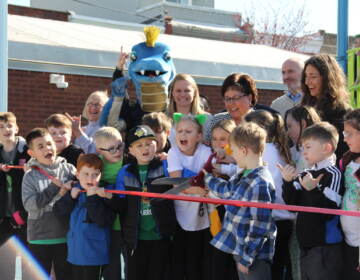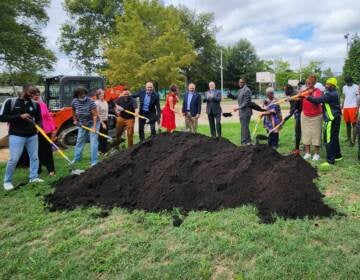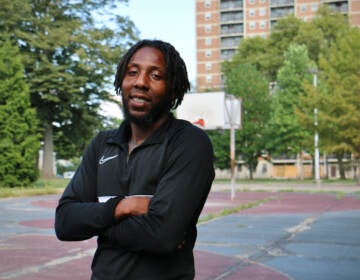When it comes to redesigning a rec center, the real experts are the kids on the courts
On his first day of work at Cobbs Creek Recreation Center, Quan King stepped through a metal doorway that led to a barren foyer.
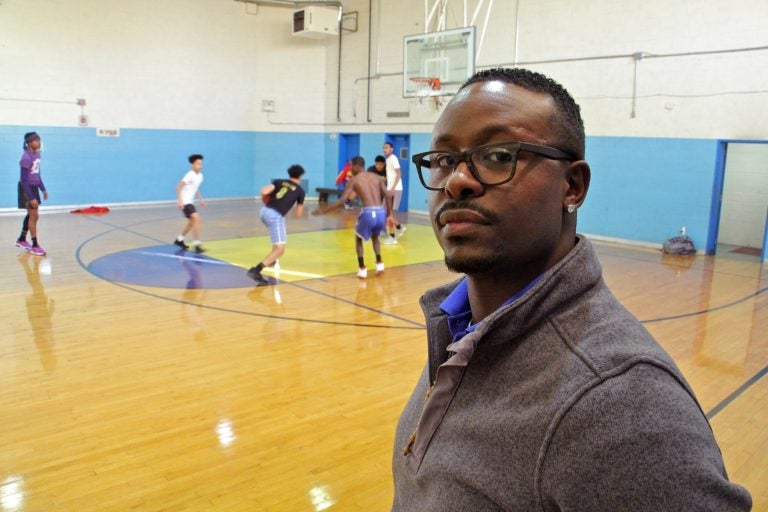
Trainee Quan King looks in on the open gym at Cobbs Creek Rec Center. (Emma Lee/WHYY)
On his first day of work at Cobbs Creek Recreation Center, Quan King stepped through a metal doorway that led to a barren foyer. It looked less like a lobby and more like an empty school cafeteria: tiled floors, harsh lighting and noisy with echoes of the goings-on emanating from deeper inside the facility. With a degree in architectural studies, King couldn’t help himself.
Couches, tables, and a rug appeared within a couple of months — each item donated from a nearby nonprofit — as the lobby slowly transformed into a lounge where the teens who frequently visited the rec center may actually want to hang out. In February, King streamed the Olympics in the newly remade lounge. High-school-aged kids settled into the couch to cheer on 17-year-old Chloe Kim as she competed for, and eventually won, a gold medal in snowboarding. “People have this notion that you can’t give communities nice things because they’ll tear it up. But I always feel like if the community believes and understands that it’s theirs, they’ll protect it,” says King, a 34-year-old rec leader trainee.
Achieving an environment where community stewardship at a public space is the norm, rather than the aspiration, requires long-term and difficult work, replete with plenty of trust-building and conflict management. But King doesn’t discount the impact that design can have in that process. “It’s amazing how structures change our perception of time and our emotions,” he says. When he sat down with PlanPhilly, King was wearing chic glasses and workout clothes. Call it an architecture-meets-athletics aesthetic. “You can walk into a space and feel confined or you can feel open or feel as though you’re not supposed to be there. There are different elements to architecture that kind of elicit different responses.” Even small physical interventions — such as King’s efforts to add simple amenities like seating — can reshape not only how patrons use a public space, but also, how they feel about it.
That’s especially true when changes to a space reflect the opinions and ideas of the community that surrounds them. Or at least that’s the trending philosophy with urban design projects today, including Rebuild. Mayor Jim Kenney’s $500 reinvestment in public facilities like rec centers, libraries and parks calls for not only making rec centers in Philly more beautiful, but also more intuitive, viewed through the lens of everyday users. “Absolutely essential to Rebuild projects is the opportunity for a broad cross-section of neighborhood residents to participate in the design process,” Rebuild executive director Nicole Westerman said in January during a meeting of the Rebuild Oversight Board, which drew roughly 100 people to Wyoming Library.
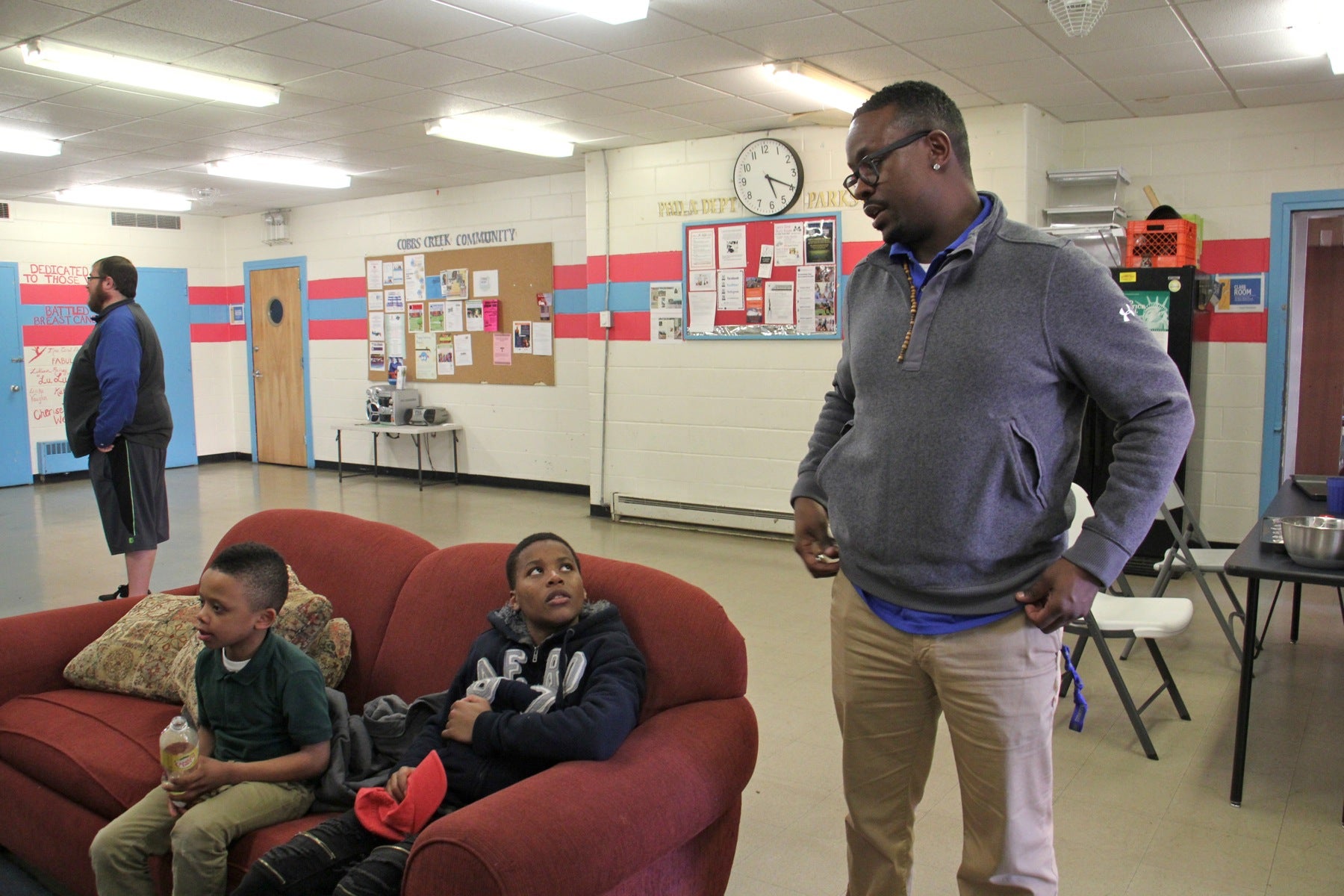
Collaborating with community members on design, while idealistic, also requires time and resources — pulled from the overall budget of Rebuild, an initiative that has already faced scrutiny surrounding its financial plan prior to meeting its goals of renovating 150 to 200 of the 406 eligible sites across the city. But looking at past projects that have drawn in community members to the design suggest the return on investment might be worth it.
“My most important accomplishment during my career was getting the citizens involved in our decision-making process,” wrote Robert Crawford, the godfather of Philadelphia’s modern recreation system in his 1993 memoir, Reflections of a Recreational Professional. Crawford served as Philadelphia’s commissioner of recreation from 1952 until 1981. Over his three decades overseeing the city’s inventory of rec facilities, he developed a sprawling empire of play based in large part on feedback from Philadelphia residents, he recalls. Even taking Crawford at his word that the city tried to mold rec centers to the needs of their users, many of these spaces no longer meet the needs of the people who rely on them. If Crawford heard people ask for large gymnasiums and baseball fields, today’s commissioner is much more likely to field demands for computers hooked up to the Internet and better maintained basketball courts and playground equipment. Yet his legacy lives on in the role that community residents have played in reshaping their rec centers.
In recent years, major renovations at Hunting Park in North Philly and Sturgis Playground in East Oak Lane have witnessed the transformative capabilities of a design process that takes community engagement to heart.
“People now come from five, six miles away just to utilize the playground here,” said Jeff Hackett, president of the advisory council for Sturgis Playground. “People come from Montgomery County to down here because they hear about the atmosphere we’ve created.”
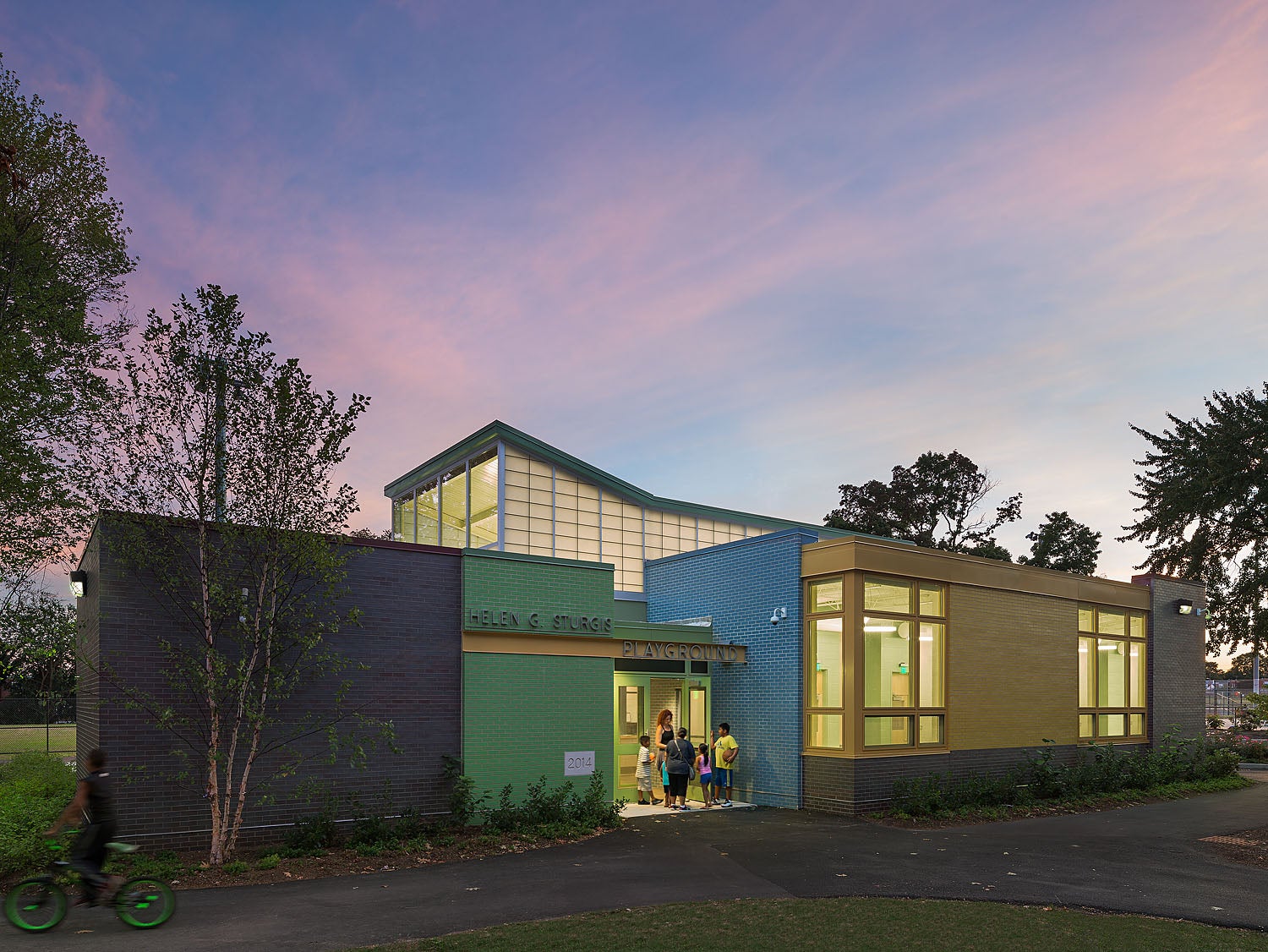
In the late-1990s, back when Hackett was hand-drawing the lines of the neglected public basketball court, there were rumbling that the city facility — which sits on a six-acre plot surrounded by tidy brick rowhomes, not far from the border with suburban Cheltenham— would be shuttered. But years of advocacy from neighbors turned it around, eventually to the tune of a multi-million-dollar upgrade that received significant political backing. In retrospect, Hackett believes the community engagement process surrounding the design of the renovations to both Sturgis’s indoor and outdoor facilities — rendered by SMP Architects — made a genuine impact on how neighbors perceive, and use, the facility.
Seemingly small tweaks to the design, Hackett believes, made an outsized impact. For example, bringing the sprayground at Sturgis closer to the favorite grassy area for parents to lounge in lawn chairs, has encouraged families to utilize the space together. Teenagers have their privacy. And different ethnic groups — from Vietnamese to Hondurans — are less divided in the park than they used to be, according to Hackett. “We used to have some conflicts between the different ethnic groups and now it’s harmonious. Everybody enjoys the space. There’s a politeness in the air,” he said.
Of course, people tend to be energized by shiny new things. Perhaps there would have been ample excitement at Sturgis whether or not the park’s neighbors had been brought in as de facto consultants. But new research suggests there are quantifiable gains when park planners talk to the real experts: the people who use the space.
In 2017, the nonprofit Center for Active Design surveyed residents in 26 cities across the country, including Philadelphia, about park design. According to the center, the study was the first to examine “specific community design features that influence civic engagement outcomes, using large-sample survey methods and visual experiments.” For example, one experiment asked survey subjects to respond to examples of various kinds of park signage. Signs emphasizing prohibitions and punitive action for violations of park rules, such as smoking, had a detrimental impact on perceptions of that public space. But signs listing permitted activities, such as high-fiving, made for much more satisfied respondents with “11 percent more likely to say they are ‘really proud to live in this community,’ and 9 percent more likely to believe “the city really cares about people in this park.’”
The authors concluded that improving the design of public facilities through the lens of the people who use them, even in small ways, can change the perception of how constituents feel about their city.
That’s also a guiding philosophy voiced by the mayor’s Rebuild team. “If we’re going to deliver projects that are both beautiful and serve the community, form has to follow function,” said David Gould, deputy director of communications and community engagement on Rebuild. “That means we need to recognize and leverage the expertise of community members, who know the needs of their neighborhood best and create equitable and transparent opportunities for them to share their experiences and priorities. We then need to marry that perspective with the expertise of designers and architects who can help bring new and exciting design ideas that address the community’s needs.”
How, exactly, will Rebuild change the look and feel of rec centers — along with parks, libraries, and rec centers? It’s too early to say whether consistent design elements will emerge and weave throughout the facility upgrades, and the Rebuild team has emphasized that there won’t even be a formulaic community engagement process — rather, one that’s tailored to each site. “We’re asking project users to think strategically and creatively around how to structure that engagement process around the needs of that specific neighborhood or community,” said Kira Strong, deputy director of design. Because, as Quan King and Jeff Hackett learned, sometimes designing around a community means a complicated master plan, and sometimes it means putting in a few comfortable seats for lounging.
WHYY is your source for fact-based, in-depth journalism and information. As a nonprofit organization, we rely on financial support from readers like you. Please give today.





